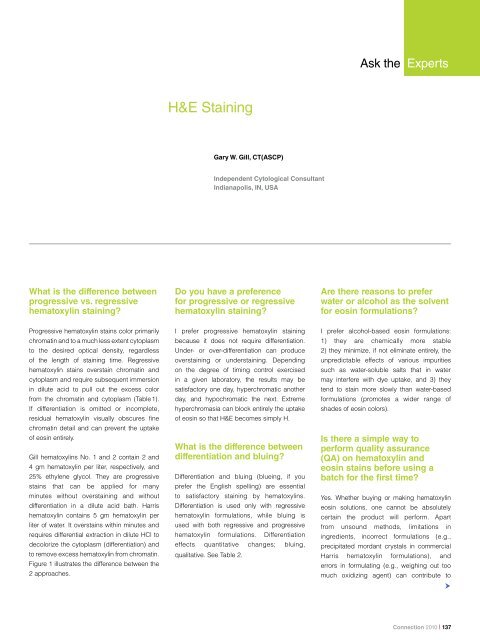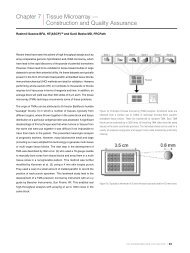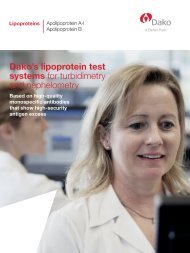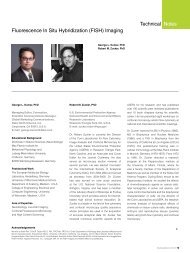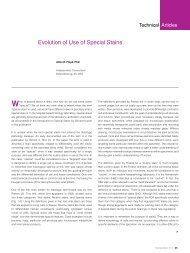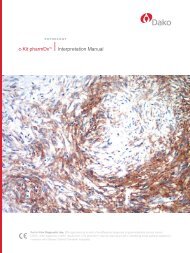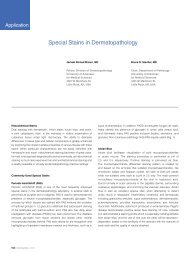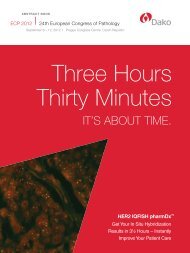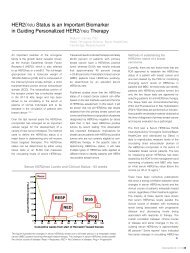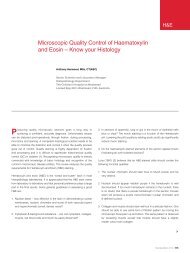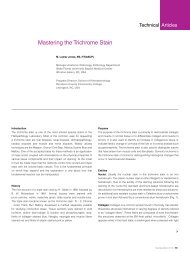H&E Staining - Dako
H&E Staining - Dako
H&E Staining - Dako
Create successful ePaper yourself
Turn your PDF publications into a flip-book with our unique Google optimized e-Paper software.
Ask the Experts<br />
H&E <strong>Staining</strong><br />
Gary W. Gill, CT(ASCP)<br />
Independent Cytological Consultant<br />
Indianapolis, IN, USA<br />
What is the difference between<br />
progressive vs. regressive<br />
hematoxylin staining?<br />
Do you have a preference<br />
for progressive or regressive<br />
hematoxylin staining?<br />
Are there reasons to prefer<br />
water or alcohol as the solvent<br />
for eosin formulations?<br />
Progressive hematoxylin stains color primarily<br />
chromatin and to a much less extent cytoplasm<br />
to the desired optical density, regardless<br />
of the length of staining time. Regressive<br />
hematoxylin stains overstain chromatin and<br />
cytoplasm and require subsequent immersion<br />
in dilute acid to pull out the excess color<br />
from the chromatin and cytoplasm (Table1).<br />
If differentiation is omitted or incomplete,<br />
residual hematoxylin visually obscures fine<br />
chromatin detail and can prevent the uptake<br />
of eosin entirely.<br />
Gill hematoxylins No. 1 and 2 contain 2 and<br />
4 gm hematoxylin per liter, respectively, and<br />
25% ethylene glycol. They are progressive<br />
stains that can be applied for many<br />
minutes without overstaining and without<br />
differentiation in a dilute acid bath. Harris<br />
hematoxylin contains 5 gm hematoxylin per<br />
liter of water. It overstains within minutes and<br />
requires differential extraction in dilute HCl to<br />
decolorize the cytoplasm (differentiation) and<br />
to remove excess hematoxylin from chromatin.<br />
Figure 1 illustrates the difference between the<br />
2 approaches.<br />
I prefer progressive hematoxylin staining<br />
because it does not require differentiation.<br />
Under- or over-differentiation can produce<br />
overstaining or understaining. Depending<br />
on the degree of timing control exercised<br />
in a given laboratory, the results may be<br />
satisfactory one day, hyperchromatic another<br />
day, and hypochromatic the next. Extreme<br />
hyperchromasia can block entirely the uptake<br />
of eosin so that H&E becomes simply H.<br />
What is the difference between<br />
differentiation and bluing?<br />
Differentiation and bluing (blueing, if you<br />
prefer the English spelling) are essential<br />
to satisfactory staining by hematoxylins.<br />
Differentiation is used only with regressive<br />
hematoxylin formulations, while bluing is<br />
used with both regressive and progressive<br />
hematoxylin formulations. Differentiation<br />
effects quantitative changes; bluing,<br />
qualitative. See Table 2.<br />
I prefer alcohol-based eosin formulations:<br />
1) they are chemically more stable<br />
2) they minimize, if not eliminate entirely, the<br />
unpredictable effects of various impurities<br />
such as water-soluble salts that in water<br />
may interfere with dye uptake, and 3) they<br />
tend to stain more slowly than water-based<br />
formulations (promotes a wider range of<br />
shades of eosin colors).<br />
Is there a simple way to<br />
perform quality assurance<br />
(QA) on hematoxylin and<br />
eosin stains before using a<br />
batch for the first time?<br />
Yes. Whether buying or making hematoxylin<br />
eosin solutions, one cannot be absolutely<br />
certain the product will perform. Apart<br />
from unsound methods, limitations in<br />
ingredients, incorrect formulations (e.g.,<br />
precipitated mordant crystals in commercial<br />
Harris hematoxylin formulations), and<br />
errors in formulating (e.g., weighing out too<br />
much oxidizing agent) can contribute to<br />
<br />
Connection 2010 | 137
Aspect<br />
Progressive<br />
Hematoxylin<br />
Regressive<br />
Hemalum concentration Less (ie, 1 to 4 gm/L) More (ie, 5 gm/L or more)<br />
Acetic acid Present Absent<br />
Rate of uptake Slow Rapid<br />
Easily controlled? Yes No<br />
Overstaining? No Yes<br />
Differentiation required? No Yes<br />
Table 1. Progressive and regressive hematoxylin formulations: similarities and differences.<br />
Figure 1. Hypothetical uptake of aluminum-hematein in cells: progressive vs. regressive staining.<br />
138 | Connection 2010
Property Differentiation Bluing<br />
Purpose<br />
Differentially extract excess hematoxylin<br />
from chromatin and cytoplasm; quantitative<br />
Convert soluble red color to insoluble<br />
blue color; qualitative<br />
Function Attacks tissue/mordant bond Oxidizes Al-hematein<br />
Used with Regressive hematoxylins Progressive and regressive hematoxylins<br />
Working pH About 2.5 5-11<br />
Common example 0.5 % HCl in 70% ethanol Scott’s tap water substitute<br />
Timing Dips Minutes<br />
Timing accuracy Critical Forgiving<br />
Risk if too brief Hyperchromasia Purple color<br />
Risk if too long Hypochromasia Decolorization if pH ≥ 11<br />
Possible negative impact Low contrast = less detail Section loss if pH ≥ 11<br />
Table 2. Differentiation and bluing: comparisons and contrasts.<br />
unsatisfactory results. It doesn’t happen often,<br />
but it does happen. Regulatory documentation<br />
does not guarantee efficacy.<br />
Formalin-fixed tissue sections or alcohol fixed<br />
buccal smears are invaluable probes to: 1)<br />
determine the performance of each new lot<br />
of stain, 2) select suitable staining times,<br />
3) find out how many slides can be stained<br />
satisfactorily by a given volume of each stain,<br />
4) learn when rinses should be changed, and<br />
5) troubleshoot whether a given stain already<br />
in use is the cause of an observed staining<br />
problem. Once experience imparts confidence<br />
to selected staining times, stain and rinse<br />
change schedules, the use of control sections<br />
or smears is not necessary for the remainder<br />
of the life of the particular stain that has<br />
been validated. However, control preparations<br />
should be used when new containers of<br />
the same stain with different lot numbers<br />
are opened to confirm that the stain does<br />
indeed perform as expected. Manufacturers<br />
occasionally make bad batches of stain.<br />
Simply looking at one of the first slides stained<br />
daily and initialing a stain quality log sheet is<br />
of no value if a laboratory has not defined its<br />
standards. It is not uncommon to see such<br />
sheets dutifully maintained and also to see<br />
unsatisfactory staining results.<br />
What role do rinses<br />
play in staining?<br />
Rinses are the neglected step-child of<br />
staining. Defined here somewhat arbitrarily as<br />
all the non-coloring solutions, rinses constitute<br />
90% of all the solutions in an H&E stain and<br />
outnumber the stains more than 10 to 1 if the<br />
initial xylene and alcohol rinses are included,<br />
yet their purposes vary and their contributions<br />
often go unrecognized. Consequently, rinses<br />
not uncommonly are overused to extremes<br />
– even becoming dilute staining solutions<br />
themselves, usually in an effort to save<br />
money. Not appreciated, unfortunately, is the<br />
hidden cost of extended, tedious microscopic<br />
examinations.<br />
<br />
Connection 2010 | 139
Complaint Cause Correction<br />
Hyperchromatic<br />
Strong hematoxylin (e.g., Harris fullstrength<br />
without acetic acid)<br />
Use lesser strength hematoxylin;<br />
Dilute 3:1 with ethylene glycol;<br />
Stain for less time;<br />
Differentiate in 0.25% HCl<br />
<strong>Staining</strong> time too long<br />
Stain for less time<br />
Inadequate differentiation in HCl<br />
Differentiate more;<br />
Use more concentrated HCl<br />
Differentiator exhausted<br />
Replace more frequently<br />
Hypochromatic Hematoxylin nearly exhausted Replace hematoxylin<br />
<strong>Staining</strong> too briefly<br />
Overdifferentiation in HCl<br />
Progressive stain differentiated<br />
Paraffin sections very thin<br />
Regressive stain overdifferentiated<br />
Acid tap water, rare (e.g., West Virginia)<br />
Chlorine in tap water (rare)<br />
Bluing in acid tap water<br />
Increase staining time<br />
Differentiate less; Use weaker HCl<br />
Do not differentiate<br />
Cut thicker; stain longer<br />
Differentiate less<br />
Use distilled water<br />
Use distilled water<br />
Use Scott’s tap water substitute (TWS)<br />
Wrong color: purple Bluing too briefly Blue longer<br />
Bluing solution exhausted<br />
No blue filter in microscope<br />
Change bluing solution daily<br />
Use microscope’s “daylight” blue filter<br />
Wrong color: gray Colored impurities Use BSC-certified hematoxylin<br />
Wrong color: brown Too much oxidizing agent Use less (e.g., 0.1 gm/gm hematoxylin)<br />
Overoxidized by long-term air exposure<br />
Store with no air space and replace<br />
Wrong site: cytoplasm<br />
Hematoxylin too concentrated;<br />
Underdifferentiation in HCl<br />
Differentiate more;<br />
Stain less time or dilute<br />
RNA-rich cytoplasm<br />
Wrong site: nucleoli<br />
<strong>Staining</strong> time too long<br />
Stain less time<br />
Ineffective eosin Y<br />
Use effective eosin Y<br />
Table 3. Troubleshooting hematoxylin staining problems.<br />
140 | Connection 2010
Complaint Cause Correction<br />
Hyperchromatic Exceeds user expectations Adjust expectations<br />
Insufficient subsequent alcohol rinses<br />
Increase rinse time, dip more<br />
Stain-laden rinses<br />
Use clean alcohol rinses<br />
Hypochromatic<br />
Al-hematein in eosin bonding sites;<br />
Eosin nearly exhausted<br />
See Table 1<br />
Replace eosin<br />
Eosin staining time brief<br />
Double staining time to start<br />
Wrong color: purple<br />
Cytoplasm has retained hematoxylin applied<br />
regressively and partially differentiated<br />
Use progressive hematoxylin or<br />
differentiate completely<br />
Insufficient subsequent alcohol rinses<br />
Use three 95% EtOH baths, dip 10 times each<br />
Stain-laden rinses<br />
Use clean alcohol rinses<br />
Table 4. Troubleshooting eosin staining problems.<br />
Among the many purposes of rinses are the<br />
following:<br />
remove paraffin<br />
effect transition from organic solvents<br />
to aqueous solutions and vice versa<br />
(i.e., hydration and dehydration)<br />
stop action of previous solution (posthematoxylin<br />
waters)<br />
differentially extract excess hematoxylin<br />
(i.e., differentiation)<br />
convert hematoxylin from red to blue color<br />
(i.e., bluing)<br />
promote redistribution of dyes within tissue<br />
(i.e., uniformity)<br />
allow expression of differential staining<br />
dehydrate (with absolute alcohol)<br />
clear (with xylene)<br />
Of the post-stain rinses, therefore, it may<br />
generally be said that the amount of stain<br />
that remains within cells represents the<br />
difference between what the staining solutions<br />
put in and the rinses take out. The posteosin<br />
rinses perform most effectively when<br />
clean. Clean simply means that there is the<br />
maximum difference in concentration gradient<br />
between the dyes in the cells and the rinse.<br />
When stained tissue is immersed in clean<br />
alcohol, the dyes diffuse effectively into the<br />
surrounding rinse. As the rinses become dyeladen,<br />
the concentration gradient is reduced<br />
and diffusion slows. When the concentration of<br />
dye in the tissue equals that in the rinse, there<br />
is zero concentration gradient and the benefits<br />
of rinsing are lost.<br />
To promote effective rinsing: (1) keep the<br />
rinses deep for maximum dilution (not just<br />
simply covering the tops of the slides when the<br />
slides are oriented horizontally, as opposed<br />
to vertically), (2) use in sets of three, (3) dip<br />
racks at least 10 times in each, and (4) change<br />
as needed. As needed means when the third<br />
rinse becomes colored with carryover dye,<br />
discard the contents of the first dish, move<br />
rinses 2 and 3 back one step to become<br />
rinses 1 and 2, and refill the third dish with<br />
fresh rinse. The third dish in each series of<br />
three post-eosin rinses should remain colorfree.<br />
Maintaining this level of quality allows the<br />
absolute alcohols and xylene rinses to remain<br />
color-free.<br />
<br />
Connection 2010 | 141
Is there a difference between<br />
quality control (QC) and<br />
quality assurance (QA) and<br />
measures for staining?<br />
I’ve read many definitions of QA and QC. QC<br />
is any material or method that is introduced<br />
prospectively into every procedure to promote<br />
a desired outcome. If a QC material or method<br />
doesn’t make a visible difference, it doesn’t<br />
make a difference and shouldn’t be used.<br />
QA, on the other hand, samples outcomes to<br />
assess whether the intended outcome was<br />
achieved. By its nature, QA is retrospective. In<br />
a word, QC imparts credibility to results; QA<br />
assesses impact.<br />
Can you describe a<br />
microscopical approach to<br />
evaluating stained sections?<br />
When microscopically examining a<br />
preparation, one must remember that one<br />
is looking not at the object itself but an<br />
image of the object that is projected onto<br />
the retina. Therefore, one needs to separate<br />
the effects of the materials and methods that<br />
interact with the object itself (i.e., fixative,<br />
sectioning, possible artifacts, stain etc.) and<br />
those that influence the image of the object<br />
(i.e., mounting medium thickness, cover<br />
glass thickness, microscope cleanliness, and<br />
optical alignment (i.e., Köhler illumination).<br />
A knowledgeable observer can assess whether<br />
the preparation is technically satisfactory and/<br />
or functionally satisfactory. If deficiencies are<br />
noted, one should be able to identify the<br />
likely cause and implement a solution. A<br />
technically satisfactory preparation exhibits<br />
no technical deficiencies. Such preparations<br />
are also likely functionally satisfactory, but not<br />
always. A functionally satisfactory preparation<br />
may exhibit technical deficiencies but still be<br />
useful for its intended purpose. This means<br />
the preparation does not have to be redone,<br />
but a solution should be implemented to<br />
ensure technically satisfactory preparations in<br />
the future. Examples of technical deficiencies<br />
include incomplete differentiation, no eosin,<br />
and excessively thick mounting medium and<br />
cover glass that cause image-degrading<br />
spherical aberration.<br />
Are there ways to<br />
systematically troubleshoot<br />
staining problems?<br />
Yes. Whether the problems are seen in<br />
hematoxylin, eosin, or any stain, wayward<br />
results can be categorized as: 1) too much<br />
stain, 2) too little stain, 3) wrong color, or<br />
4) wrong site. See Tables 3 and 4. If the<br />
problem is too much stain, put less in by<br />
using a less concentrated stain for the same<br />
staining time or staining for less time with the<br />
same concentration. It’s vice versa when the<br />
problem is too little stain.<br />
What is Scott’s tap<br />
water substitute?<br />
Scott’s tap water substitute (TWS) is an<br />
aqueous bluing solution with pH 8, which is<br />
an intermediate value along the range of pH<br />
within which bluing can occur (i.e., 5 to 11).<br />
Scott’s TWS is prepared by dissolving in 1<br />
liter of water 2 gm sodium bicarbonate and<br />
either 10 gm anhydrous magnesium sulfate<br />
(MgSO4) or 20 gm hydrated magnesium<br />
sulfate (MgSO4 ∙ 7H2O [Epsom salts]). If you<br />
prepare this solution, be aware that dissolving<br />
magnesium sulfate is an exothermic reaction<br />
that can get unpleasantly warm. For safety,<br />
wear goggles and gloves. To minimize risks,<br />
add the magnesium sulfate slowly to the<br />
water so it dissolves rapidly and dissipates<br />
the heat produced. Alternatively, laboratorians<br />
who prefer to use Scott’s TWS can purchase<br />
it readymade. Scott’s TWS was described<br />
in an article published nearly a century ago<br />
(Scott SG. On successive double staining<br />
for histological purposes (preliminary note).<br />
J Path Bact. 1911-1912;16:390-398).<br />
How often should one replace<br />
in-use hematoxylin and eosin?<br />
Predictably, the answer is “it depends.” On the<br />
supply side, it depends on: 1) concentration<br />
of dye, 2) volume of staining bath, 3) number<br />
of dips, and 4) how well pre-stain rinses are<br />
maintained. On the demand side, it depends<br />
on the number of intracellular bonding sites<br />
for hematoxylin and eosin, which is a function<br />
of: 1) thickness and area of tissue sections,<br />
2) relative proportion of chromatin and nonchromatin<br />
(e.g., malignant tissue has higher<br />
concentrations of nuclear chromatin than<br />
normal tissue), and 3) number of slides.<br />
If your laboratory maintains a steady workload,<br />
you might want to replace hematoxylin and<br />
eosin at regular intervals or ad hoc. It is<br />
helpful to keep a well-stained section available<br />
as a visual reference against which stained<br />
sections can be compared.<br />
Can 1-step hydration and<br />
dehydration replace graded<br />
alcohols of hydration<br />
and dehydration?<br />
Yes. Historically it has been customary to<br />
use series of graded percentage alcohols to<br />
hydrate or dehydrate specimens (e.g., 95%,<br />
80%, 70%, and 50%, and vice versa). The<br />
rationale has been that shrinkage-distortion<br />
of cells and tissue sections is minimized<br />
by such stepwise displacement of alcohol<br />
142 | Connection 2010
or water. Another suggested reason is that<br />
gradual decreases or increases in alcohol<br />
concentration minimize the convection<br />
currents that otherwise occur, and are plainly<br />
visible, when specimens go directly from<br />
alcohol to water or vice versa.<br />
In practice, neither event is observed.<br />
Regardless of the closeness of alcohols in<br />
percentage, shrinkage inevitably occurs. The<br />
final amount is neither greater nor lesser<br />
than that which results from 1-step hydration<br />
and 1-step dehydration procedures (i.e., 95%<br />
ethanol to water in one step and vice versa).<br />
Nor does increased cell loss occur. The<br />
currents seen moving around a slide that<br />
has gone from alcohol to water, or water to<br />
alcohol, are diffusion currents, not convection<br />
currents. Diffusion currents are concentration<br />
gradient-based; and convection currents are<br />
temperature gradient-based. Differences in<br />
the refractive index of water and alcohol<br />
exaggerate the visibility of the diffusion<br />
currents when dehydration or hydration takes<br />
place in a single step.<br />
To blend the diffusion currents immediately<br />
and minimize any agitation effects they might<br />
produce, repeatedly dip the slides as soon<br />
as they are immersed. Dipping also ensures<br />
uniform rates of shrinkage or swelling in<br />
tissue, and thus minimizes the likelihood of<br />
poorly affixed sections becoming detached<br />
from the glass surface. The pH of the water<br />
has no effect on subsequent staining. The pH<br />
of the stain solutions influences the uptake<br />
of dyes.<br />
What does “clearing”<br />
accomplish?<br />
Suffusing fixed protein with a solution such<br />
as xylene that has a similar refractive index<br />
minimizes light diffraction and promotes nearly<br />
optically perfect images. Fixed protein has a<br />
refractive index of about 1.536; histological<br />
grade xylene, 1.5. (• Baker JR. Cytological<br />
Technique - The Principles Underlying Routine<br />
Methods. Methuen, London, 1960 (4th<br />
edition,) • Crossmon GC. Mounting media for<br />
phase microscope specimens. Stain Technol.<br />
1949;24(4):241-7). Clearing is the term applied<br />
to immersing fixed tissue sections in a solution<br />
of nearly matching refractive index and the<br />
transparency it enables. Formaldehyde-fixed<br />
tissue is comprised mostly of proteins and<br />
nucleic acids and some carbohydrates; the<br />
lipids for the most part have been dissolved<br />
out. The protein is naturally transparent, but if<br />
allowed to remain dry it will diffract light waves<br />
that pass through it.<br />
Can a lab “go green”<br />
with its H&E staining?<br />
Yes. Relative to the 3 Rs of saving the<br />
environment: reduce, reuse, recycle:<br />
Reduce alcohol use: substitute 0.5%<br />
glacial acetic acid in water for 95%<br />
ethanol as a rinse wherever possible. This<br />
concentration of acetic acid is weaker than<br />
that of household vinegar. It is also less<br />
expensive than alcohol and not flammable.<br />
Suggested Reading<br />
1. Brown RW (Ed.). Histologic Preparations: Common<br />
Problems and Their Solutions. College of American<br />
Pathologists, Northfield IL, 2009.<br />
2. Dumas T. ‘Going green’ in the lab. MLO. 2009;41(5):48-<br />
49. Accessed November 1, 2009 at: http://www.mloonline.com/features/2009_may/0509_education.pdf.<br />
3. Kiernan JA. Histology FAQ <strong>Staining</strong>, Histochemistry and<br />
Histotechnology. Accessed October 5, 2009 at: http://<br />
www.ihcworld.com/_faq/histology-faq/misc/m6.htm.<br />
4. Luna LG. Histopathologic Methods and Color Atlas of<br />
Special Stains and Tissue Artifacts, American Histolabs,<br />
Gaithersburg MD, 1992 (767 pages).<br />
5. Thompson SW, Luna LG. An Atlas of Artifacts<br />
Encountered in the Preparation of Microscopic Tissue<br />
Sections, Thomas, Springfield IL, 1978 (190 pages).<br />
6. Wallington EA. Artifacts in Tissue Sections. Med Lab Sci.<br />
1979;36(1):3-61.<br />
To maintain the effectiveness of 1-step<br />
hydration and dehydration rinses: 1) keep<br />
the solutions deep for maximum dilution (not<br />
merely covering the tops of the slides when the<br />
slides are oriented horizontally, as opposed to<br />
vertically), 2) dip racks immediately at least<br />
10 times in each, 3) use in sets of 3, and 4)<br />
change as needed.<br />
Reuse xylene forever: use water scavenging<br />
beads in xylene (see URL in next bullet).<br />
Recycle alcohol or xylene using Creative<br />
Waste Solutions and Suncycle Technologies<br />
products (http://www.cwsincorp.com/;<br />
http://www.suncycletech.com/).<br />
Connection 2010 | 143


